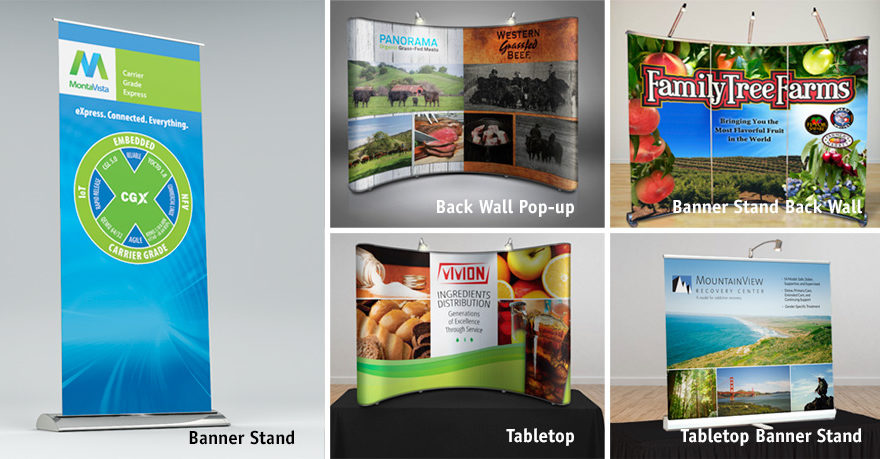That big trade show that was only a glimmer in your eye when you booked it months ago is approaching as fast as a runaway train. After taking care of all the other details, it’s time to come up with a plan for your booth. What your booth looks like will depend on the product or service you provide, the type of show, the size of your space, and other factors. Maybe you’re new to exhibiting and would like to know what your options are.
Portable displays are well suited for the most common exhibit space, a standard/linear or inline booth. This space is 10 feet wide by 10 feet deep (referred to as a 10 x 10) and have neighbors on either side. The maximum height for the back wall is typically 8 feet. A variation on this space is the perimeter booth, which is an inline booth that backs up to a perimeter wall so you don’t have a neighbor behind you. The maximum height for the back wall is usually higher — up to 12 feet.
Besides being perfect fits for the standard booth space, portable displays have many other advantages. They’re lightweight and easy to assemble. Since they collapse into a compact size and come with their own case, they travel well. They can easily be managed by a small staff — one person can set it up and break it down. It’s easy to change and update the graphics and you can almost always find one that fits your budget from one of many manufacturers.
So, let’s take a look at three of the most common types of portable displays:
Popup
At roughly 10 feet wide by 8 feet high, a popup makes a great back wall for a standard booth. It consists of an accordion-like framework that expands and stands on its own, with graphic panels that attach to the frame magnetically or a seamless fabric that fits over the frame like a pillowcase. They usually come with an optional lighting system and one person can set it up in under 20 minutes. If properly designed, a popup is a highly visible canvas for your brand and message. By having extra panels designed you can have multiple graphics with specific messaging and swap them out for particular shows.
Tabletop
Ranging in size from 4 feet by 3 feet to 8 feet by 5 feet, there are different styles of tabletop display, but the most professional-looking, in my opinion, is the popup. They’re just like a back wall popup but much smaller, so they fit on a standard 6-foot or 8-foot table. The types of graphic materials they use is also similar to their larger cousin.
Banner Stand
A banner stand has a retractable screen — much like the movie screen your history teacher pulled down to show the class a film, only upside down — housed in an aluminum stand. The graphics are digitally printed on vinyl, paper, or fabric, and when set up the display is typically about 3 feet wide by 7 feet high, although sizes vary by manufacturers and models. They’re very easy to set up, lightweight, and can travel anywhere in a handy carrying case. A banner stand can be a great compliment to a popup display in a 10 x 10 booth or can come in a set of three to form its own back wall. They’re also great for smaller spaces. Perhaps you’re exhibiting at a table in the lobby of a convention and just need a small display to set up next to the table. Some models can even be pulled up to partial height so they can be used as a tabletop. The banner stand is the utility infielder of trade show displays.
Whichever type of portable display you choose, you’ll want a professional design for your graphics. That display has to represent your company to thousands and thousands of people. Be sure it’s something you and your staff are proud to stand in front of. Check out my portfolio then contact me for a free consultation to find out how I can help.
